Coluber constrictor
| Coluber constrictor | |
|---|---|
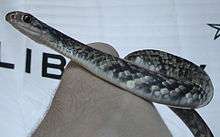 | |
| Buttermilk Racer Coluber constrictor anthicus | |
| Scientific classification | |
| Kingdom: | Animalia |
| Phylum: | Chordata |
| Subphylum: | Vertebrata |
| Class: | Reptilia |
| Order: | Squamata |
| Suborder: | Serpentes |
| Family: | Colubridae |
| Subfamily: | Colubrinae |
| Genus: | Coluber |
| Species: | C. constrictor |
| Binomial name | |
| Coluber constrictor Linnaeus, 1758 | |
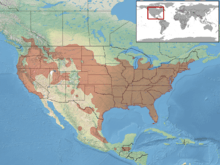 | |
| Synonyms | |
Coluber constrictor is a species of nonvenomous, colubrid snake, endemic to North America and Central America. Eleven subspecies, including the nominotypical subspecies, are recognized, which as a group are commonly referred to as the eastern racers.
Geographic range
They are primarily found throughout the United States, east of the Rocky Mountains, but they range north into Canada, and south into Mexico, Guatemala and Belize.
Description
Adult Eastern racers can typically vary from 50 to 152 cm (20 to 60 in) in total length depending on the subspecies, but a record-sized specimen measured 185.4 cm (73.0 in) in total length.[3][4][5] A typical adult specimen will weigh around 556 g (1.226 lb), with little size difference between the sexes.[6] The patterns vary widely between subspecies. Most are solid-colored as their common names imply: black racers, brown racers, blue racers, or green racers. "Runner" is sometimes used instead of "racer" in their common names. All subspecies have a lighter-colored underbelly: white, a light tan, or yellow in color. Juveniles are more strikingly patterned, with a middorsal row of dark blotches on a light ground color. The tail is unpatterned. As they grow older, the dorsum darkens, and the juvenile pattern gradually disappears.[3]
Behavior
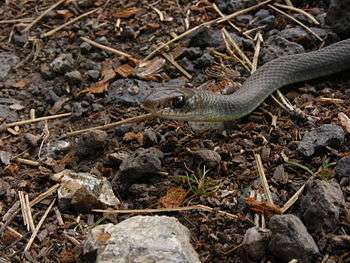
Racers are fast moving, highly active, diurnal snakes. Their diet consists primarily of small rodents, frogs, toads, lizards, and other snakes.[7] Some subspecies are known to climb trees in order to eat eggs and young birds. Juveniles often consume soft-bodied insects, such as crickets and moths . Despite their specific name, constrictor, they do not really employ constriction, instead simply subduing struggling prey by pinning it bodily, pressing one or two coils against it to hold it in place instead of actually suffocating it. Most smaller prey items are simply swallowed alive.
They are curious snakes with excellent vision, and are sometimes seen raising their head above the height of the grass they are crawling in to view what is around them. Aptly named, racers are very fast and typically flee from a potential predator. However, once cornered they put up a vigorous fight, biting hard and often. They are difficult to handle and will writhe, defecate and release a foul smelling musk from their cloaca. Rattling their tails among dry leaves, racers can sound convincingly like rattlesnakes.[8]
Habitat
Frequently near water but also in brush, trash piles, roadsides, swamps, suburbia; it is the most common snake in residential neighborhoods in Florida. It spends most of its time on the ground, but it's a good tree climber and may be found in shrubs and trees where bird nests can be raided for eggs and chicks, as well as small adult birds such as finches, canaries, and thatchers.
Most racers prefer open, grassland type habitat where their keen eyesight and speed can be readily used, but they are also found in light forest and even semi-arid regions. They are usually not far from an area of cover to hide in.
Reproduction
Mating takes place in the spring, from April until early June. Around a month later the female will lay anywhere from 3 to 30 eggs in a hidden nest site such as a hollow log, an abandoned rodent burrow, or under a rock. The 8-10" (20–26 cm) long juvenile racers hatch in the early fall. Maturity is reached in approximately 2 years. Racers have been known to lay their eggs in communal sites, where a number of snakes, even those from other species, all lay their eggs together.
Symbol
"The black racer snake was adopted because it is native to all 88 Ohio counties and is called the 'farmer's friend' because it eats disease-carrying rodents."
Ohio Governor's Residence[9]
The northern black racer is the state reptile of Ohio.[10]
Subspecies
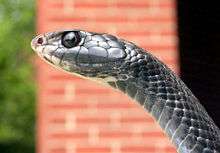
- Coluber constrictor anthicus (Cope, 1862) - buttermilk racer
- Coluber constrictor constrictor Linnaeus, 1758 - northern black racer
- Coluber constrictor etheridgei Wilson, 1970 - tan racer
- Coluber constrictor flaviventris Say, 1823 - eastern yellowbelly (or yellow-bellied) racer
- Coluber constrictor foxii (Baird & Girard, 1853) - blue racer
- Coluber constrictor helvigularis Auffenberg, 1955 - brownchin racer
- Coluber constrictor latrunculus Wilson, 1970 - blackmask racer
- Coluber constrictor oaxaca (Jan, 1863) - Mexican racer
- Coluber constrictor paludicola Auffenberg & Babbitt, 1955 - everglades racer
- Coluber constrictor priapus Dunn & Wood, 1939 - southern black racer
- Coluber constrictor mormon (Baird & Girard, 1852) - western yellow-bellied racer[11]
Gallery
-
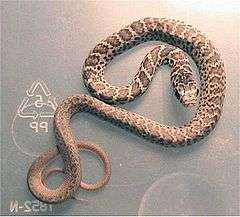
Juvenile Yellowbelly Racer, C. c. flaviventris
-
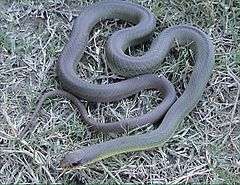
Adult Yellowbelly Racer, C. c. flaviventris
-

Northern Black Racer, C. c. constrictor
-

Northern Black Racer, C. c. constrictor in typical habitat
-

Black Rat Snake, Elaphe obsoleta obsoleta, often confused with Racer
Notes
- ↑ Stejneger, L.H., and T. Barbour. 1917. A Check List of North American Amphibians and Reptiles. Harvard University Press. Cambridge, Massachusetts. 125 pp. (Coluber constrictor, p. 79)
- ↑ The Reptile Database. www.reptile-database.org.
- 1 2 Conant, Roger. 1975. A Field Guide to Reptiles and Amphibians of Eastern and Central North America, Second Edition. Houghton Mifflin. Boston. 429 pp. ISBN 0-395-19977-8 (paperback). (Coluber consrictor constrictor, pp. 178-179 + Plate 26 + Map 139.)
- ↑ "Species profile: Minnesota DNR". Dnr.state.mn.us. Retrieved May 2013. Check date values in:
|access-date=(help) - ↑ "Southern Black Racer, Racer (Florida Museum)". Flmnh.ufl.edu. Retrieved May 2013. Check date values in:
|access-date=(help) - ↑ Habitat Use and Thermal Ecology of Ratsnakes (Elaphe Obsoleta) and Racers ... - Gerardo L. F. Carfagno - Google Books. Books.google.com. Retrieved May 2013. Check date values in:
|access-date=(help) - ↑ "Corkscrew's common snakes: Black Racer (Coluber constrictor priapus)". Corkscrew Swamp Sanctuary. Retrieved May 2013. Check date values in:
|access-date=(help); External link in|publisher=(help) - ↑ School of Computer Science. "UMass Amherst: The College of Natural Sciences". Umass.edu. Retrieved May 2013. Check date values in:
|access-date=(help) - ↑ "Ohio's state symbols". Ohio Governor's Residence and Heritage Garden. Retrieved February 13, 2011.
- ↑ "5.031 State reptile". LAWriter: Ohio Laws and Rles. Lawriter LLC. 2008. Retrieved January 22, 2011.
- ↑ Eastern and Western Yellow-bellied Racers, COSEWIC Assessment and Update Status Report
References
- The IUCN Red List of Threatened Species
- "Black Snakes": Identification and Ecology - University of Florida fact sheet
- Racer - Coluber constrictor Species account from the Iowa Reptile and Amphibian Field Guide
- University of Michigan, Animal Diversity Web: Coluber constrictor
- Species Coluber constrictor at The Reptile Database
External links
| Wikimedia Commons has media related to Coluber constrictor. |
-
 "Blacksnake". Encyclopedia Americana. 1920.
"Blacksnake". Encyclopedia Americana. 1920.

